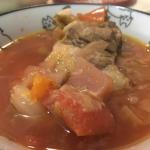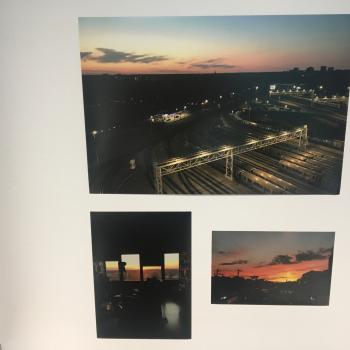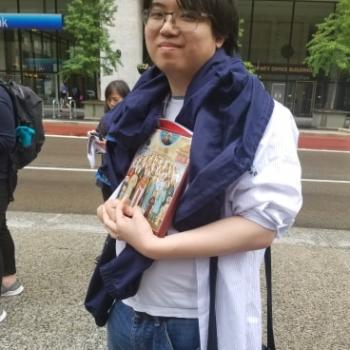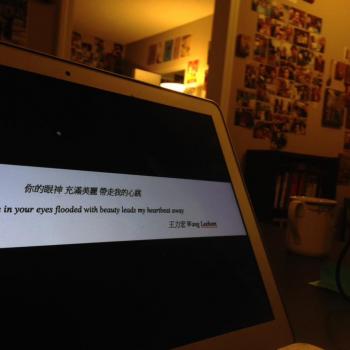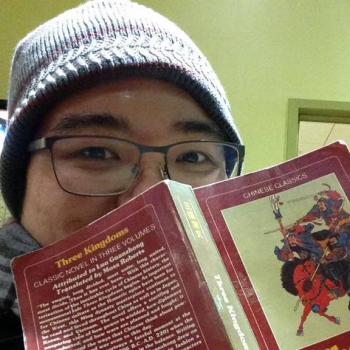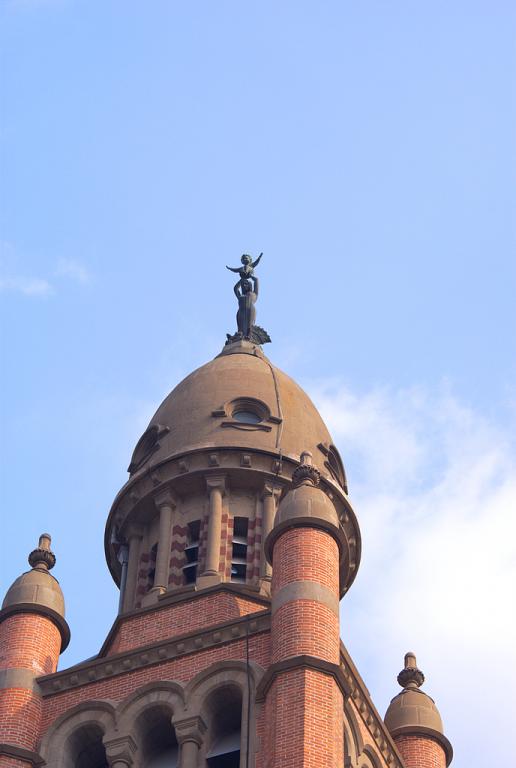
On the Feast of the Holy Great-Martyr Eugenia of Rome on the forefeast of the Nativity, I had the sudden urge to contemplate the Mother of Sheshan. I suppose that is what I get for trying to integrate my Chinese Christianity in a serious way with my newfound Eastern Catholic practice in the Kyivan Church. When I began this task earlier in the fall, it was admittedly something that I was trying to do for myself alone. I had a past in Chinese evangelicalism, and I wanted to take it seriously as part of my spiritual journey, scatter-brained demonology and all. In so doing, I reflected on it seriously, especially in thinking about the Holy Wonderworkers Nicholas of Myra and John of Shanghai and San Francisco. But after the disastrous fallout of the Vatican-China deal and the reports of authoritarian attempts to forcibly sinicize religious groups (including with over a million Uyghurs in re-education camps), repress Marxists and Maoists, and jail human rights lawyers, I came back to our temple in Richmond, and we held a service for the persecuted church in China. Perhaps all that was in the background as Nativity approached. By the actual day, I found myself thinking a great deal about the Mother of Sheshan, maybe even to the chagrin of some of my Kyivan compatriots who might balk at the possible latinization that might ensue in my spirituality.
The truth is, I had probably not thought about the Mother of Sheshan seriously for years, not since my catechumenate, probably. I was, I admit, drawn to her when I first began considering in a more serious way whether to become Catholic, and as part of my journey, I found myself attending a Latin parish known for its ministry to Chinese Catholics in Richmond even while finding myself inexplicably drawn to the Eastern Catholic Church. At that time, I felt that the two Marian figures to which I felt a deep connection, the Black Madonna of Belz-Częstochowa and our Mother of Sheshan, exemplified the Second Vatican Council’s document Gaudium et spes on the church’s relationship with the modern world. Ever since I had gotten to know Joseph Cardinal Zen Ze-kiun during my doctoral fieldwork in Hong Kong — research from which I am drawing for my forthcoming book, as well as for my ongoing work on the aftermath of the Umbrella Movement — I had also felt that that pastoral constitution somehow also expressed my spirituality, in the sense that the ‘joys and the hopes, the griefs and the anxieties of the men of this age, especially those who are poor or in any way afflicted, these are the joys and hopes, the griefs and anxieties of the followers of Christ’ (Gaudium et spes 1). The Theotokos holding the Child aloft at Sheshan, or the Theotokos gesturing to the Child who has one hand on the Gospel while blessing with the other — is this not expressive of a kind of Catholic humanism, the personalism that has shaped a Catholic sense of the supernatural and the dignity of the human person in a world that is fundamentally spiritual?
It is good, I reflect, that I had about a three-year break in musing on the Mother of Sheshan. I find that this process is important in breaking spiritual obsessions, in the sense that when I become overheated in infatuation for a theological figure, it is probably symptomatic of a kind of interior immaturity that leads me to transfer my problems onto the images and concepts in idolatrous ways. Back three years ago, my obsession was probably fueled by the fact that my grandfather was from Shanghai and was screwed over as a landowner by both Japanese fascists and Chinese communists. This time, I find my reflections calmer, more measured, and a little less about the politics of identity. The Mother of Sheshan, I found, gave physical shape to the declaration we pronounced in the Nativity Compline service: God is with us! Understand this, all you nations! And submit yourselves, for God is with us! This God is the Child held aloft by the Theotokos, oddly conceived here in surprisingly Orthodox terms not only as in the Latin theological understanding of her as a passive figure who offers her docile yes to God, but more importantly as an active agent in the history of salvation who bears God in the world and who pictures our own bearing of the Lord in our midst in our liturgical worship. It is, I reflected, similar to what I said to my sister and brother Summer and Julian when we attended the Faith Community of St Sabina in Chicago the week before I left for Richmond. Fr Pfleger’s sermon that week revolved around the theme, I am pregnant with a purpose, with the Theotokos’s pregnancy of God picturing our own Christian life in bringing the kingdom into the world. I leaned over to whisper into my friends’ ears: This is Orthodox theology. They nodded with enthusiasm. As in the words of the irmos to the ninth ode of the Nativity canon: I behold a strange, most glorious mystery: Heaven — the cave; the Cherubic Throne — the Virgin. The manger — the place where Christ lay; the uncontainable God whom we magnify in song.
While I am a little surprised that the Mother of Sheshan in particular has come back into my life this way, I am glad for it. Even in terms of problematizing the division between the official and underground churches — she was, after all, restored after the Cultural Revolution by the official bishop Aloysius Jin, who was himself restored to communion with the Latin Church — the Mother of Sheshan reminds me of what it means for the Nativity to hold a central place in my spirituality. I have been reflected that it is a little strange that the birth of Christ occupies such a key point in my prayer that I try to take its icon everywhere I go, but perhaps the opportunity that the Mother of Sheshan offers me is a constant reminder that the Nativity is a political event. It is the Mother of God offering the Son of God to the world over against its destructive tendencies, and this at heart is what it means that she is the Immovable Wall who protects the city from destruction. The world, she contends, is constituted by the supernatural grace of her Son, who is revealed in his birth. Our Saviour the Dayspring from the East has visited us from on high, the exapostilarion for Nativity Matins reads, and we who were in darkness and shadow have found the truth, for the Lord is born of the Virgin!
Holding aloft the Saviour of the world, the Mother of Sheshan re-enters my prayer this Nativity, perhaps in some ways an outworking of the Chinese Christianity that I contemplated over St Philip’s Fast. Maybe this is a spiritual prompt to situate what I mean by Chinese Christianity even more as I work out how I remain as such in the Kyivan Church, especially in a piece that the most recent issue of Patriyarkhat has graciously published in its most recent issue. As I ponder this possibility, I also reflect that it is not a return to a sense of ethnicity — what, after all, is Chineseness, really? — but a call to understand the situation in China as symptomatic of the post-political modus operandi of using law and policy to quash the people’s political agency writ large in the world.
In this way, the offering of the Mother of Sheshan is a return to a culture built on the dignity of the person, in which politics is in our vocation. In this depiction of the Immovable Wall, the city that will not be taken is constituted by the politics that my spiritual father says is ‘close to my soul,’ the capacity for a human person’s thinking and feeling to become a real engagement with the way that the world is arranged. The Christ who is born is not a substitute for the political, in the sense that regimes around the world (including the Chinese one) have pretended to be so for the people they govern. He comes to show that the dignity of the human person is in our actual social relations, the way we materially interact with friends and enemies and live out the condition of our hearts in the world. Is this not, I reflect, the same thing for which Sun Yatsen once praised Chinese people in jest for being a ‘sheet of scattered sand’ who know perfectly how to be free because their immediate concerns tend to revolve around their families, clans, and communities? To reflect on Chinese Christianity in this sense is not to fall back into ethnophyletism; it is to ponder the human condition within a specific situation so as to give theological buttressing for an advocacy for politics itself. To speak so universally as opposed to the insular spiritual obsessions of my past, I muse even as I write, perhaps indicates that nearly three years after my chrismation, the Mother of Sheshan re-enters my life to show me that I truly am finally becoming Catholic through this Kyivan Church. Even by meditating on the Oranta of Kyiv, I have not become an honorary ethnic Ukrainian. Instead, what seems to be happening is that it is bringing me back to the heart of Chinese Christianity, which I have always known and practiced, and showing me how to be truly Catholic through it.
Most Holy Theotokos, Immovable Wall whose upraised hands in prayer atop the cathedral in Sheshan show her Son who is born this day to the world, save us!


